Explosive Uncertainty

However, a few months after the Syriam bombing, which was followed by another blast three days later at Rangoon City Hall that killed three people and injured four others, MI arrested Ko Ko Naing, a KNU agent, who admitted to carrying out both attacks. But this did not help the detained NLD activists, most of whom were forced to serve out their sentences despite the fact that the MI knew they were innocent. Only after nearly two decades were some of the prisoners finally released. Meanwhile, Ko Ko Naing was freed in 2007 after serving less time than the NLD death row detainees, who remain behind bars to this day.
 |
| Polic investigate the site where bombs exploded during the New Year's festival in central Rangoon.(Photo: REUTERS) |
“Because bomb blasts expose the weakness of the junta’s security apparatus, the regime’s first reaction is to round up and imprison anyone they can implicate, just to show that they are in control of the situation,” he said. “It doesn’t really matter to them if their prisoners are innocent, or if the people who really carried out the attack are still at large.”
While the regime seems content with locking up the usual suspects, however, it is clear that this does nothing to prevent future attacks—a threat that appears to be growing, along with the roster of possible perpetrators of violent acts targeting Burma’s urban areas.
Doubts about the case against Phyo Wai Aung don’t necessarily preclude the possibility that groups such as the ABSDF—or rather, radical elements loosely associated with the former student army—may have had a hand in the Thingyan attacks. Sources close to the ABSDF say that many active and inactive members based along Burma’s borders with Thailand and China remain committed to armed struggle against the Burmese regime, despite pressure from international donors to abandon the use of violence. Among them, the sources said, are some who are turning increasingly to urban warfare tactics in their efforts to overthrow the junta.
“Although the ideology of armed struggle has lost favor with many in the two decades since the ABSDF was formed, there remains a hardcore element that seeks to use any means available to undermine the junta’s grip on power,” said one source, adding that support for urban guerrilla tactics, including the use of explosives, has grown since the regime’s brutal crackdown on the 2007 demonstrations.
Because the ABSDF never officially renounced its right to oppose the regime by force, its health and education projects have faced funding problems stemming from the unwillingness of many aid agencies to finance the group. This has not, however, prevented more militant members from finding money to pay for training in making explosives and other areas of military expertise. Sources say that funding for such activities comes from private donors—mainly Burmese exiles based overseas—who have lost faith in the NLD’s nonviolent struggle to push Burma toward democracy.
But while disgruntled former student activists may have the means and motives to carry out sporadic bombing campaigns in major urban centers, they are hardly alone. Ethnic insurgent armies based along Burma’s borders have long regarded the country’s cities as legitimate targets. What makes the current situation particularly volatile is the growing restiveness of a host of ethnic cease-fire groups chafing under pressure to join the Burmese regime’s proposed border guard force (BGF) scheme, which would strip them of the quasi-autonomy they have enjoyed since they ended active hostilities.
Unlike the KNU and other groups that remain at war with the junta, the cease-fire armies have a significant presence in Burma’s major cities, including Rangoon, Mandalay, Moulmein and Lashio. Even if they were forced to withdraw to their bases along Burma’s borders in the event of a breakdown of their cease-fire agreements with the regime, they would still have intelligence networks in the cities.
« previous 1 | 2 | 3 | 4 next page »
